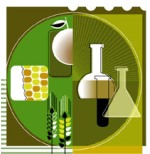
Skyscrapers, bullet trains, space shuttles, submarines, laptops, antibiotics, screenplays, governmental systems, language, playing cards: the creative impulse that we possess and endlessly deploy saturates our landscapes. Nearly anywhere we look we see traces of our creative handiwork. And now, with our advanced genetic technology, nearly everything we eat bears traces of our creativity.
During a trip through North Dakota, two ecologists from the University of Arizona encountered a chance discovery that provoked an extended research study. While resting at a pit stop in Cavalier County professor Cindy Sagers and graduate student Meredith Schafer spied “these beautiful yellow flowers blooming.” They quickly identified these flowers as canola plants and, with their curiosity sparked, they investigated whether or not the canola plants were a natural or genetically modified strain.

After classifying and testing the plants, Sagers and Schafer found “clear evidence of the escape of these genetically modified plants.” With these surprising results in hand, they returned to the road, but with a new impetus. Sagers and Schafer began to run similar tests on canola plants every five miles. After a year-long study covering 3,000 miles of North Dakota territory producing 406 samples of canola plants, Sagers and Schafer presented their findings to the Ecological Society of America. Out of the 406 samples taken, 86% (349 of 406) were positively identified as genetically modified strains. Furthermore, as Geoffrey Brumfiel reports in his article “Genetically Modified Canola ‘Escapes’ Farm Fields” two of the canola samples “contained traits from multiple genetically modified varieties – suggesting that genetically modified plants are breeding in the wild.” Sagers, commenting on the import of her study, declared: “We’ve demonstrated a large-scale escape of a genetically modified crop in the United States.”
North Dakota’s farmland is the richest source of canola in the US. The canola grown there is used in cooking oil, animal feed, and some biodiesels. Brumfiel records that North Dakota farmers “will plant over 1 million acres of canola” in the upcoming year, and ninety percent of this canola seed will be genetically modified. Genetic modification of the seeds helps protect the canola plants from “two types of herbicides, glufosinate and glyphosate.”
Brumfiel, seeking responses from other professionals in the field, turned to Mike Wilkinson of Aberystwyth University (UK) and Linda Hall from the University of Alberta (Canada). Wilkinson dismissed potential fears about the spread of genetically modified strains of canola into the wild noting that although seedlings may spread rapidly they tend not to fare well. Hall, echoing Wilkinson’s perspective, claimed, “It’s pretty spoiled – it’s used to growing in well-fertilized, clean seedbeds without competition, so it does not do well if it is having to compete with other plants.” According to Sagers, Wilkinson and Hall are correct: genetically modified canola will not replace wild strains of canola; but this does not diminish the key point of her study, that is, “future varieties of genetically modified crops will escape into the environment.”
We, homo sapiens, the human animal, are a creative force. We, who have been given a gift, that is, the imago Dei, the image of God, are a creative force with incredible scope. The products of our creativity are capable of generating planetary effects. The natural environment that was once a source of great fear for our ancestors has now been brought under human dominion to a sizeable degree. Yet, in light of bombs that can destroy our world and carbon emissions that are melting our ice caps, our creative capacities appear to have outstripped our foresight. As we continue to genetically modify the food we eat while not fully comprehending the potential affects this practice may have (on the environment and our bodies), might wisdom be on the side of patience? Might this be an opportunity for us to learn from our mistakes? Might this be an opportunity to learn from past experience that shows our creative products sometimes have hazardous effects that we did not foresee? Maybe it is time to let our foresight and understanding catch up with our awe inspiring creativity.
Links
To read Geoffrey Brumfiel’s article, “Genetically Modified Canola ‘Escapes’ Farm Fields” for Morning Edition on WBUR/NPR please click here.


